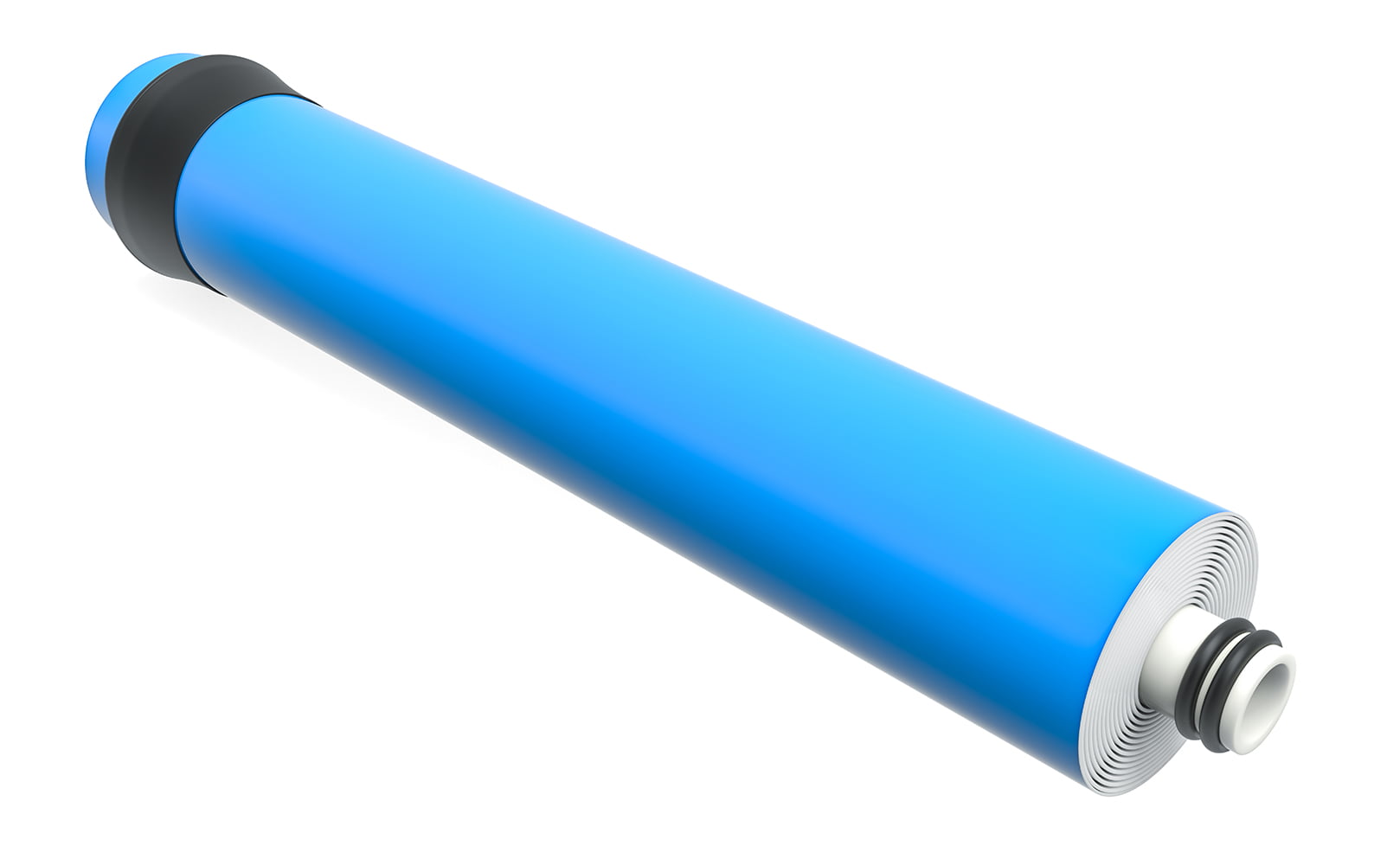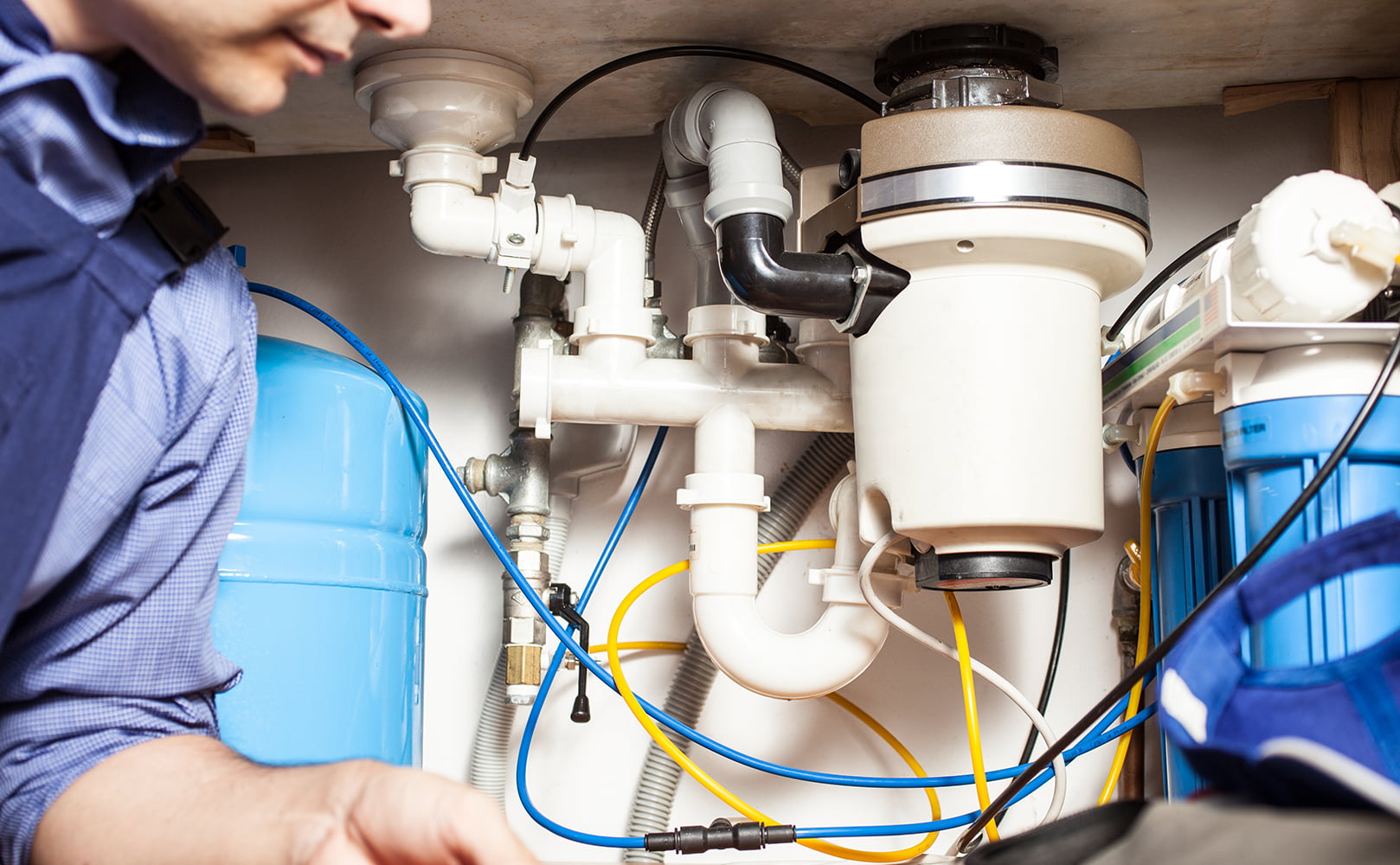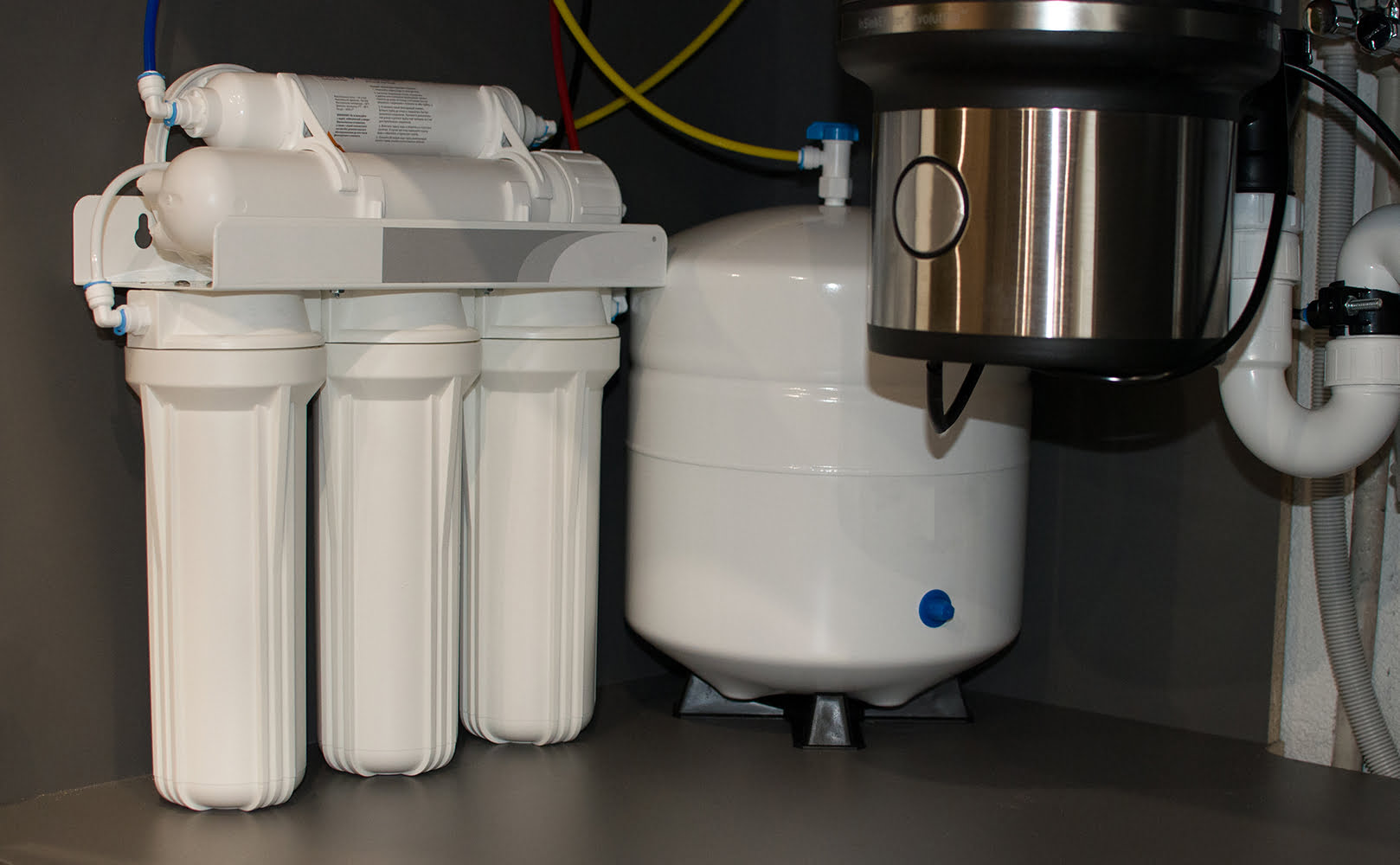What Is Reverse Osmosis Water Filtration and How Does It Work?
Written by: Gene Fitzgerald // Last Updated: May 3, 2023
This page may contain affiliate links. If you buy a product or service through such a link we earn a commission at no extra cost to you. Learn more.
Reverse osmosis water filtration is widely regarded as one of the best methods available for purifying water. It results in clean, fresh-tasting water free of nearly all contaminants.
Reverse osmosis specifically refers to the filtration process whereby feed water is forced through a semi-permeable membrane to separate filtered water from contaminant-filed waste water.
This article will focus on the RO filtration process itself and not the reverse osmosis system, which typically features additional pre and post-filter stages in addition to the reverse osmosis membrane.
So, let’s take a closer look at reverse osmosis water filtration, what it is, and how it works in step-by-step detail.
Key Takeaways
- Reverse osmosis is an advanced form of water filtration capable of removing a wide array of impurities from water.
- The basic principle behind reverse osmosis involves forcing feed water through an ultra-fine membrane – the reverse osmosis membrane – to separate water into two streams: One is the feed water (permeate) which is sent onward, and the other is the contaminant-filled waste water which is sent down the drain.
- The way the RO membrane works is it’s semipermeable. This means it rejects certain substances but not others. To be more precise, reverse osmosis membranes reject almost everything except water molecules which are allowed to diffuse through them.
- As RO membranes are incredibly fine, they are capable of removing nearly any contaminant over 0.0001 micron in size. This includes floating particles, microorganisms, metals, pesticides, salts and minerals, VOCs, and almost all other organic and inorganic water contaminants.
Definition: What Is Reverse Osmosis Water Filtration?
First of all, what is reverse osmosis water filtration?
Reverse osmosis water filtration refers to any water filtration process which uses a reverse osmosis membrane to separate filtered water from contaminant-filled waste water. Reverse osmosis membranes are used in residential, commercial, and industrial applications, as well as in desalination facilities.
How Does Reverse Osmosis Work?
How does reverse osmosis work?
Reverse osmosis works by using water pressure to force-feed water through an ultra-fine RO membrane – rejecting even the tiniest of contaminants. As RO membranes are incredibly fine, they can separate any contaminant particle larger than .0001 microns from water – meaning they will remove microbial contaminants, heavy metals, pesticides, herbicides, all kinds of salts, and much more.
What Is Osmosis?
To understand reverse osmosis, it’s important to understand the scientific term osmosis. You might have a general idea of this term if you paid attention during science class, but a precise definition is helpful:
Osmosis is a natural phenomenon in which water from a weaker saline solution will migrate through a semipermeable membrane into a stronger saline solution. The migration will stop once both solutions are equally concentrated.
This is just how water naturally behaves. No external pressure is needed for osmosis to work.
In terms of real-world examples, think of how a tree’s roots will absorb water from the soil, or how the skin on your hands and feet will prune if you sit in a bath for a long time.
Reverse osmosis is essentially the osmosis process in reverse. As this is the opposite of what would naturally occur, external water pressure is required to force the stronger saline solution (the unfiltered water) through the RO membrane and into the weaker saline solution (the filtered water).
Without significant water pressure, the reverse osmosis process would not work. This is also why RO membranes will not work efficiently if the feed water pressure is too low.
How Does a Reverse Osmosis Membrane Work?
Reverse osmosis membranes use the principle of reverse osmosis to separate water into two separate streams, and then dispose of the contaminant-filled waste water while sending the filtered water onward.
Feed water enters the RO membrane chamber and is forced through the membrane element under high pressure. Due to the ultra-fine membrane mesh, any contaminants larger than the membrane’s pores will stay trapped on one side – while only clean water molecules will pass through to the other side. Not all water makes it through, though. So at this point, the contaminant-filled waste water is sent down the drain, and the filtered water flows onward to the next filter stage.
One of the only downsides of reverse osmosis is that it can generate a significant amount of waste water. This is largely unavoidable, but there are several methods to reduce or recycle this waste water.
Salt Rejection Percentage
The salt rejection percentage is a method of determining the effectiveness of an RO membrane in removing contaminants. This method gives you a good idea of the effectiveness of your system using a basic water voltage meter.
The formula is as follows:
Salt Rejection % = (Conductivity of Feed Water – Conductivity of Filtered Water) / Conductivity of Feed Water x 100
The higher the salt rejection percentage, the better the RO membrane is performing. A well-functioning system will reject 95% to 99% of feed water salts.
What Does Recovery Rate Mean?
The recovery rate is a metric that measures the percentage of input water that is recovered as permeate (filtered) water. In other words, it measures the percentage of water that is not sent down the drain as waste water. A higher recovery rate indicates less water is being wasted, but as each reverse osmosis process is different, the ideal recovery rate will vary from system to system.
The recovery rate formula is calculated as follows:
Recovery Rate % = Permeate Flow Rate / Feed Flow Rate x 100
The recovery rate will also be influenced by the quality of your water. Water with higher total dissolved solids (TDS) can lead to scaling and fouling which in turn leads to less efficient membrane operation.
Reverse Osmosis Membrane Operating Conditions
While reverse osmosis is a highly effective water filtration method, it will not work properly in all conditions. RO filtration requires the maintenance of water pressure and temperature within a specific range as well as specific turbidity levels. Certain elements like iron and manganese must also be controlled to a specific level:
Required Operating Conditions of TFC Reverse Osmosis Membranes
| Parameter | Requirement |
|---|---|
| Feed Water Pressure | 40-85 psi |
| Water Temperature | 40-100°F (5-35°C) |
| Water pH | 2.0-11.0 |
| TDS | < 2000 ppm |
| Turbidity | < 1 NTU |
| Calcium Carbonate Level | < 350 ppm |
| Iron Level | < 0.05 ppm |
| Manganese Level | 0 ppm |
| Hydrogen Sulfide Level | 0 ppm |
| Chlorine Level | < 0.1 ppm |
What Does Reverse Osmosis Remove from Water?
Reverse osmosis removes a wide array of contaminants from water, but it does not remove everything. This is why reverse osmosis systems are typically sold with various pre and post-filters – to complement the membrane filtration process. But this article will focus only on RO and not the additional filter stages.
Reverse osmosis will remove the following dissolved ions:
- 98% of aluminum
- 98% of ammonium
- 96% of arsenic
- 96% of barium
- 96% of cadmium
- 88% of chloride
- 94% of chromium 6
- 97% of copper
- 88% of cyanide
- 88% of fluoride
- 96% of iron
- 96% of lead
- 96% of manganese
- 97% of mercury
- 97% of nickel
- 68% of nitrates
- 97% of phosphate
- 95% of selenium
- 90% of sodium
- 97% of sulfate
- 97% of sulfite
- 97% of zinc
In addition to the above dissolved ions, reverse osmosis can remove radioactive contaminants like radium and uranium. It will also remove most pesticides and herbicides, VOCs, and even more heavy metals and salts. Microbial contaminants like bacteria, viruses, and cysts will be effectively removed as well, although reverse osmosis is not the preferred method for this.
Reverse osmosis can also remove large particles like sand, silt, and sediment, although these will lead to premature clogging of the membrane – which is why sediment filters are typically paired with RO systems.
Because reverse osmosis membranes are so effective, they will also remove healthy minerals like magnesium, potassium, and calcium. This is not a major issue though, as contrary to popular belief, drinking water is not a significant source of essential minerals in humans. If you are concerned about these minerals being removed, you can always add them back in using a remineralization filter.
What Is Not Removed?
While reverse osmosis water filtration will remove the large majority of contaminants, it isn’t 100% effective against all of them.
Contaminants not removed by reverse osmosis:
- Dissolved gasses: Dissolved gasses, due to their tiny molecular weight and low charge can pass through a reverse osmosis membrane. Gasses such as radon, carbon dioxide, chlorine, and hydrogen sulfide will pass through RO membranes.
- Certain pesticides: Reverse osmosis will remove most pesticides from water, but not all. Atrazine and trichlorobenzene in particular can be problematic.
- Organic compounds like benzene and total trihalomethanes (THMs). These substances are solvents that can easily dissolve in the RO membrane and then migrate over to the filtered side.
Why Is Reverse Osmosis Water Purification Beneficial?
Advanced Water Filtration
Reverse osmosis provides one of the most thorough water filtration methods available. It will remove a wide array of both organic and non-organic pollutants including lead, nitrites, arsenic, fluoride, pesticides, and more.
Reverse osmosis is such an effective process that it will even strip away beneficial minerals from your drinking water, one of its only downsides.
Water Aesthetics
As reverse osmosis is so effective at removing contaminants, it will strip away nearly everything from your feed water – leaving you with remarkably pure, clean-tasting water. As it also removes sodium and other minerals, you’ll be removing many of the particles that can impart an ‘off’ taste.
RO will also improve water’s aesthetics, removing turbidity and other particles that can make water less appealing.
Healthy Drinking Water
Reverse osmosis water is highly pure. Not only is it better tasting, but as the vast majority of problematic particles are removed, any health concerns can be alleviated.
Cost
Without getting into a whole discussion on how much RO systems cost, we can safely say that RO filtered water costs less than many other filtration methods. This is especially true when you compare the costs of RO water with the costs of bottled water.
Additionally, once you have an RO filter installed at home, the ongoing maintenance costs are fairly minimal.
Flexibility
RO filters can be purchased in a variety of different sizes and configurations, so finding one to fit your filtration needs is not an issue.
Reduces Bottled Water
Lastly, RO water will significantly reduce your plastic waste when compared to regularly purchasing bottled water. This will have a positive environmental effect in addition to alleviating any concerns over chemical leaching from plastic bottles.
Reverse Osmosis Cons
Waste Water
One of the major downsides to reverse osmosis filtration is the creation of waste water as part of the process. This is unavoidable – and shouldn’t be seen so much as a downside but rather as a necessity.
Generally speaking, RO membranes for home use will generate waste water at a ratio of about 4 parts waste water to one part filtered water (permeate). This can be mitigated to a large degree by installing a pump to increase the system’s efficiency. Installing one can reduce this ratio from 4:1 to 1:1 or even as little as 1:4.
RO waste water can also be collected and reused, rather than being flushed down the drain. Waste water contains a high level of contaminant particles, so it’s not fit for drinking, but it can still be used for household chores like floor mopping, cleaning patios or driveways, gardening, or washing clothes.
Mineral Loss
As mentioned previously, reverse osmosis water filtration will strip away beneficial minerals along with harmful contaminants. This means magnesium, calcium, and potassium among others will be removed during the treatment process.
The good news as far as mineral loss is concerned is that water is actually not a significant source of minerals in our daily intake.
If this still is of concern to you, there are remineralization stages that can be added to RO systems to add back minerals that were stripped away by the membrane.
Filtration Speed
Another downside of RO filtration is that it is a slow process. It takes a significant amount of time for water to pass through the membrane, which is why RO systems often utilize storage tanks to keep a reserve of filtered water on hand at all times.
There are also tankless systems, which use powerful pumps to push water through the system at a more rapid speed. These units are more expensive, though.
Space Requirements
When it comes to home RO units, they require a decent amount of space for installation. If you don’t have the necessary space, then you may need to install it in a nearby cabinet.
Flat Taste
This one is not much of an issue for most people, but as reverse osmosis removes nearly everything from water safe for pure water molecules, it can leave a bit of a flat taste to some people. This is generally only an issue in the beginning and most people get used to the flavor quickly.
What Are the Basic Components of a Home Reverse Osmosis System?
The basic components of RO water filter systems are:
Feed Water Valve
The feed water valve is the valve that connects the cold-water supply to your RO system. In whole house systems, this will be connected to the home’s main water line.
Pre-Filter Stages
Pre-filter stages remove certain contaminants which can adversely affect the function and lifespan of the RO membrane. The two biggest problem contaminants are chlorine/chloramine and sediment.
Chlorine and chloramine are common disinfection products used in municipal water treatment to eliminate harmful microbes. Unfortunately, they will also damage the RO membrane, so they are removed using an activated carbon pre-filter.
Sediment, silt, sand, and rust will also clog a reverse osmosis membrane, and as such must be removed before they can reach said membrane. A sediment pre-filter is used to remove these large particles.
RO Membrane
The RO membrane is the heart of any RO system and does the heavy lifting when it comes to contaminant removal. It uses an ultra-fine membrane to remove a wide variety of contaminant particles over 0.0001 microns.
Storage Tank
As the filtration process is often very slow, a storage tank is needed to keep a reserve of filtered water on hand at all times. The tank size will vary depending on the size of the system, but you can order one to suit your needs.
RO tanks are pressurized for them to work with the pressure in the rest of the system. The pressure in the tank allows the filtered water to flow to the RO faucet without the need for a pump. The tank pressure also works to trigger the automatic shut off valve, which tells the system when to start and stop filtering water.
Post-Filter Stages
After the water has passed through the pre-filter and RO membrane, it will flow through one or more final post-filter stages designed to remove anything left over.
Typically, an activated carbon filter is used as post-filter to polish the water. Sometimes a UV light post-filter is used to eliminate any microbial contaminants. Remineralization stages can be used to counter mineral loss.
Automatic Shut-Off Valve
The automatic shut off valve (ASO) is an important system component used to shut off the filtration process once the water in the tank has reached a certain level. Without the ASO, the system would continuously flush water down the drain.
Check Valve
Another important system component is the check valve. This valve is designed to prevent water from flowing backward into the RO membrane housing – which could damage or rupture the membrane.
Flow Restrictor
The flow restrictor is connected to the drain line and works to prevent excess water wastage. It also functions to maintain pressure inside the RO membrane housing.
Drain Line
The drain line runs from the RO membrane housing outlet to the drain pipe.
RO Faucet
Under sink RO systems only filter water flowing out of a single outlet – typically on the sink top. Point-of-entry systems, on the other hand, filter water flowing through the entire home.
What to Consider When Buying a Reverse Osmosis Treatment System
- NSF Certifications: NSF certifications are the best way to ensure you’re getting the filtration level advertised by the manufacturer. Certain organizations independently test and issue certifications for a variety of household appliances, including water filtration systems. Look for Standard 42 (aesthetic effects), Standard 53 (health effects), Standard 58 (point-of-use RO systems), and Standard 401 (emerging compounds).
- Filter Stages: RO systems come in several different configurations and number of filter stages. Aside from the membrane, commonly used filters are sediment pre-filters, activated carbon pre-filters, carbon post-filters, UV light filters, remineralization filters.
- Installation and Maintenance: Ease of installation and maintenance is another important consideration when buying a reverse osmosis system. Countertop RO systems are the easiest to install and only require a water line connection to a standard kitchen faucet. Under sink units are slightly more complex but generally can be installed on your own if you have basic DIY skills. Whole house RO systems are the most complex to install, and although they can be installed on your own, hiring a plumbing professional to ensure the correct installation can make sense.
- Water Usage: Your water usage requirements will dictate the system size you’ll need. Typical under sink units can filter 50 to 75 gallons per day, while whole house units can filter significantly more – in the 500 to 5000+ range.
- Water Pressure: Water pressure must fall in a specific range for a reverse osmosis system to work properly.
- Budget: Most under sink systems will only cost several hundred dollars, while whole house systems run into the thousands. When calculating the cost of a system, be sure to include the cost of filter and membrane replacements.
- Waste water Ratio: Pay attention to the ratio of waste water generated to filtered water produced. Most basic systems have a ratio of 4:1, although this can be reduced by installing a pressure or permeate pump.
How Long Does an RO System Last and How to Maintain One?
Reverse osmosis systems will last approximately 10 to 15 years provided they are well-maintained and regularly serviced. This number refers to the lifespan of the system itself and not to the lifespan of the individual filters and membrane.
The precise lifespan of an RO system will depend on how much you use it as well as the quality of the feed water. Water with a high level of dirt, dissolved solids, or hard water will prematurely age the system.
When it comes to maintenance, the only major task required are regular filter changes, periodic cleaning and sanitizing, and ensuring the storage tank has sufficient pressure.
Filter changes plus cleaning and sanitizing the system involves removing the filters and membrane from their housings, adding a small amount of cleaning solution, scrubbing, and then flushing the system with water before installing the new filter elements. This should be done every 6 to 12 months.
RO storage tanks need to be kept within a specific pressure range to work properly with the rest of the system – typically 6 to 8 psi when empty. If you notice the faucet dispensing water slowly, then you’ll need to add pressure to the tank by emptying it and repressurizing it using a bike pump or air compressor.
If you have any questions about how RO works please don’t hesitate to leave a comment below!
Information provided on BOS is for educational purposes only. The products and services we review may not be right for your individual circumstances.
We adhere to strict editorial guidelines. Rest assured, the opinions expressed have not been provided, reviewed, or otherwise endorsed by our partners – they are unbiased, independent, and the author’s alone. Our licensed experts fact-check all content for accuracy. It is accurate as of the date posted and to the best of our knowledge.





